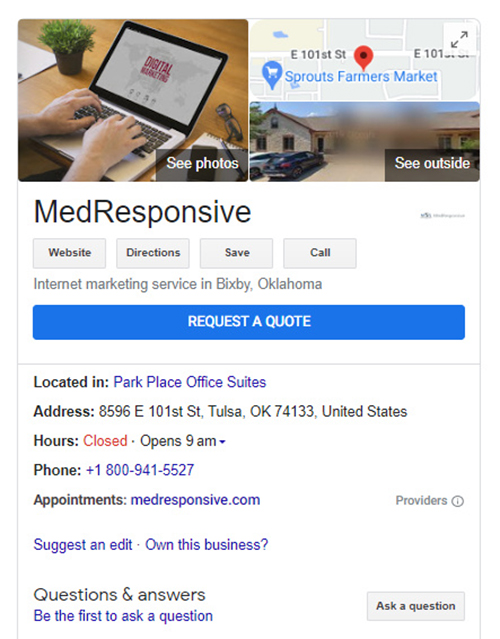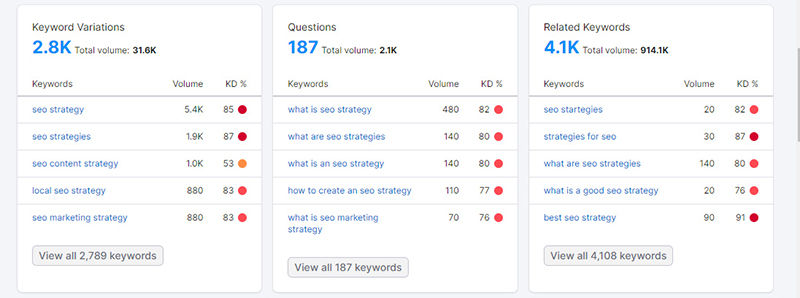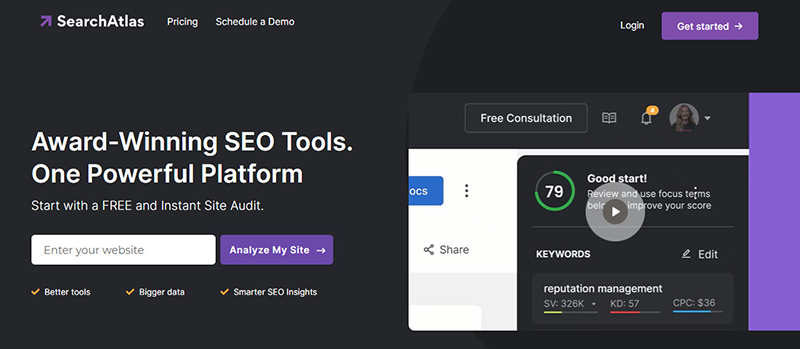Google has released numerous changes and updates over the past year. With updates like the Link Spam Update and the Page Experience Update, Google is on a quest to eradicate black hat SEO techniques in order to enhance the SERPs, putting an emphasis on high-quality content, ideal page loads, and mobile SEO. Setting up an effective ecommerce SEO strategy for 2023 is crucial, given the frequent changes going on with Google’s algorithm. A trustworthy search engine optimization company can assist e-commerce websites in keeping up with the most recent SEO updates, enhancing your search exposure, and building a solid SEO base.
Top Ecommerce SEO Strategy
The planning and execution of actions that aim at enhancing organic search engine rankings constitutes an SEO strategy, and SEO is at the core of any successful e-commerce website. In order to increase your organic search engine visibility and the number of new customers coming from Google and other major search engines, you need a solid ecommerce SEO strategy. So, here are the main seo strategies that you should focus on for the year 2023.
- Begin with keyword research: Keyword research is the first step in every SEO plan for ecommerce websites. By using this procedure, you can make sure that your on-page SEO strategy is focusing on the proper keywords and that your eCommerce SEO efforts are being maximized. The common error that businesses make is to concentrate on short keywords, but long-tail keywords are stronger indications of customers’ search intent because people who are specifically looking for something are more likely to buy it. The three primary approaches to keyword research are as follows. You have multiple options for performing in-depth keyword research, such as using a variety of search engines to view the most popular search results, researching your competitors to become familiar with the kinds of material you should concentrate on, or using versatile keyword tools like Google Search Console, SEMrush, Google Keyword Planner etc. Do all three if you are able to.
- Develop unique content that impacts SEO: Good content is still king. The importance of quality content which includes images, articles, videos etc draws more customers to your store and sets your company apart from the competition.
- Quality content: Your content has to be original, worthwhile, and presentable. Provide relevant content that your target audience finds engaging and informational. It should be error-free, and an original copy with appealing images. Further, you should think about E-A-T when developing content (expertise, authoritativeness, and trustworthiness). Google uses E-A-T to make sure the results it provides to users are accurate, true, and useful. Therefore, when ranking a web page in search results, it takes into account the competence, authority, and reliability of the individual developer of the page content, the content itself, and the overall website.
- Video content: More than 82% of all consumer internet traffic is made up of video content. By including informative videos, you may enhance user interaction on digital and social platforms while educating your audience in an accessible format. Existing and potential customers frequently watch product reviews and demo videos which are frequently more helpful than instruction manuals, interviews that encourage discussions thematically related to a brand or its products or services, and videos that explain and help viewers understand more about how a product or service works or why they might benefit from either.
- Optimize images: It refers to shrinking the size of an image without compromising its quality. Your website will load pages more quickly, perform better in search engine results, and receive more traffic. Optimization and accessibility involve more than just employing compression techniques to make images smaller. Use your own photos rather than stock photography, and make sure the visuals are pertinent to and reinforce the theme of the associated content. Stock photo purchases could appear to be more affordable, but if you need to make new purchases for each social media post and each website page, the prices can quickly mount.
- Core Web vitals: Core Web Vitals (CWV) constitute a set of three measures that rate a user’s experience when loading a website, and this was launched by Google in 2020. These are recognised ranking factors that affect SEO. The three interaction measurements that make up Core Web Vitals are the highest contentful paint, the first input delay, and the cumulative layout shift. Simply put, Google evaluates how rapidly page content loads, how quickly a browser can process user input while loading a web page, and how stable the material is as it loads in a browser. CWV offers your target audience a better user experience even though it doesn’t immediately increase organic results. And, higher conversion rates follow from that. In a nutshell, it’s comparable to a “page experience” score, which is Google’s method of assessing the overall UX quality of your webpages. In 2023, one of the most important aspects of SEO will be to increase the Core Web Vitals of your website by streamlining third-party script loading times, stabilizing loading, and optimizing server loading times.
- Voice search optimization: Voice search has become increasingly popular over the past year, with 58% of consumers finding local companies using it and 71% of consumers saying they prefer to use voice search over typing, both of which have had a big impact on SEO trends.
Customers that utilize voice search typically employ 29 words, usually long-tail terms. You should focus on optimizing highlighted snippets and knowledge graphs since Google mainly relies on them to respond to voice queries. You may draw voice search users to your eCommerce site by having a good domain rating and optimizing it for local searches.
- Create or Update Google Business Profile: Through 2022, mobile searches continued to outnumber desktop searches, accounting for 60% of all searches. Mobile search also outperforms desktop when it comes to discovering local businesses. So, it’s time to create your Google Business Profile, if you haven’t already. You lose out on local search traffic and the chance for improved reputation management without a business profile. In case you already have a Google Business Profile, look over your pictures, testimonials, and inquiries. Spend some time updating your business’ photographs, responding to both positive and negative reviews, and answering any queries that potential customers may have.

Learn more: How to Create a Google My Business Page
- Clean your links: Broken internal and external links can prevent Google from crawling your website, which will harm your SEO. Make use of the Page Explorer tool to perform a Site Audit.
- Use the Inaccessible and Orphaned report to identify broken links and pages that don’t load.
- First, address the pages that receive the most organic traffic and search impressions.
- Replace or redirect all internal connections, and swap outgoing links for more recent, relevant ones.
- Improve backlink outreach and remove toxic backlinks: Backlinks directly impact the domain rating of your website. When it comes to inbound links, low-quality links can hurt your DR while high-quality links can help it. Although it takes effort, building backlinks is worthwhile. Targeting websites with high DR ratings, start a link outreach programme or employ a service to speed up the link-building procedure. Your backlink profile’s quality can be improved by providing top-notch guest posts. In a similar manner, be sure to delete harmful backlinks. Negative backlinks can seriously harm how Google sees your website. When your pages are falling in the SERPs, getting rid of poor quality backlinks is like severing an anchor. Utilize the Backlink Analyzer to collect your backlink data. Utilize Google’s disavow tool to then submit files for deletion.
- Optimize for Google Discover: Google Discover is crucial to SEO since it is a significant portion of Google Search that enables people to keep up-to-date on topics that are important to them. It enables you to connect with customers who are prepared to learn about and support your eCommerce company. Regardless of when they were published, Discover displays both fresh content and the most popular article entries. Discover’s reporting functionality in Search Console is essential to any company’s content strategy since it gives brands useful information about the performance of their content. With this knowledge, businesses can enhance their content, boost their search engine rankings, and raise their chances of showing up in Google Discover. Continue creating user-centric content for Google Discover as this is the greatest method to optimize it.
Learn more: Top 10 Ways to Optimize for Google Discover Feed
- Mobile optimization: Shoppers are using their mobiles and tablets more frequently. In fact, 79% of smartphone users completed an internet transaction over the last six months. The mobile version of a website is also indexed by Google. It goes without saying that your website won’t rank well if it isn’t responsive. A website that is mobile-friendly is one that is optimized to work on all platforms, ensuring that users enjoy themselves whether they purchase on a desktop or a mobile device. Online retailers who don’t put up a real, purposeful effort to provide a good mobile shopping experience run the risk of falling far behind their rivals.
- Get Rid of Underperforming Pages: Pruning your pages that don’t meet your criteria or pages that have keyword cannibalization issues is a good way to be ready for the New Year. Using the SearchAtlas Page Pruning tool, you can quickly find underperforming pages that could be harming the overall quality of your site’s content and design.
- Refresh existing content: You can start updating your current content if your content strategy is functioning properly. This allows you to give your blogs more depth while also letting Google know that your content is still current. To find pages that aren’t maximizing their SEO potential, use GSC Insights’ Top Pages feature. Remember to update meta tags as you make changes to blogs and landing pages, especially for pages with lots of impressions but low clickthrough rates. Another excellent technique to animate your websites is by including rich media. Remember to make your pages accessible as well.
- Underline your strengths: Customer trust in your brand is increased by displaying endorsements and reviews and setting up structured data.
- Ask for client testimonials: Customers adore social proof, also known as outside validation, and use it to decide if they should do business with you. As long as it’s simple, most customers don’t mind sharing testimonials. As a result, many eCommerce businesses request them once a customer makes a purchase via mail or directly through their app.
- Structured Data Setup: Structured data improves search results by helping search engines comprehend the content of your web page more quickly and accurately. By tagging information on your website in this way, you raise your chances of showing up in rich snippets, which, in contrast to standard Google search results, display more data. Rich snippets offer a better click-through rate than organic results since they rank higher, which increases traffic to your website.
- Diversify Your Marketing Platform: Search engines love to see organic traffic coming from various sources, such as social media sites, email addresses, etc., to your online business. Also, if you don’t use a variety of marketing methods, you won’t be able to make the kind of money you want. The demand for your product or service is increased through marketing across a variety of platforms (those that your target market utilizes), which also helps to increase brand recognition and conversions from the top of the funnel all the way to the bottom. Diversifying your channels also expands the reach of your brand, making it simpler for people to find your goods or services. Getting exposure through various platforms enables you to reach current and potential clients where they are. After all, people won’t just find you through your website.
- Highlight Product Reviews: Similar to recommendations, specific product reviews show customers they can trust you while also sending a strong signal to search engines that increases the authority of your online store. The most effective technique to allay a customer’s doubts about your goods and services, in my opinion, is through product reviews. Given that 90% of consumers read reviews before making purchases, requesting and displaying them is definitely worth the effort.
Google will undoubtedly roll out a number of changes in 2023. By concentrating on best practices, you’ll be well-positioned to respond to any future modifications that Google releases. However, you could approach a search engine optimization company to customize your ecommerce SEO strategy according to the specifics of the updates.
MedResponsive is a SEO company with many years of experience in providing digital marketing solutions for diverse businesses.








